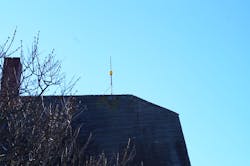Every year I spend the holidays with my mother in Wisconsin. Each time I’m there, I look outside her living room window and see the lightning protection rod on the roof of the house across the street. It has always amused and perplexed me why a lightning protection system would have been installed on a house built in the middle of Wisconsin in the late 1930s. But there it is in all its glory.
Lightning protection is one of those engineering systems that is a mystery to many, and often a value engineering target for those who do not understand the purpose of a lightning protection system. Like many other engineering systems, lightning protection is not necessarily a “design preference,” but the need for a lightning protection system is determined by the requirements of NFPA 70 and NFPA 780, a lightning risk assessment, and oftentimes the facility’s insurance carrier.
Merriam-Webster defines lightning as “the flashing of light produced by a discharge of atmospheric electricity; also: the discharge itself.” We know that lightning is a 30,000A to 100,000A example of this concept. Considering most residential circuits are 15A, the magnitude of one lightning strike is a significant amount of energy. (Yes, I know voltage affects the direct equivalency of energy, but we are looking at magnitude here — and man is it significant.)
So, if lightning is inevitable, why invest in those air terminals, conductor cables, and ground rods? Why not just let the lightning strike as it may and let the building dissipate the energy to ground?
The primary reason for a lightning protection system is to route that electrical energy to a less destructive path to ground — instead of traveling through the building’s electrical wiring, water piping, structure, or low-voltage cabling paths where it could create significant chaos inside the building. A lightning protection system does not completely eliminate the damage that can be caused to a structure, but it can certainly decrease the damage by routing the energy directly to ground instead of giving it free reign of the building. Even with the air terminals and down leads, there is always a risk of side-flash, which is one of the primary reasons the NEC requires all low-voltage cabling to be located a minimum of 6 ft from lightning protection cables. Low-voltage cabling is like a wick to that much electrical energy.
Not all areas of the country are as susceptible to lightning strikes, and not all structures require a lightning protection system. The location, height, and configuration of a structure play a big part in determining if a lightning protection system is necessary. Appendix L of NFPA 780: Standard for the Installation of Lightning Protection Systems provides guidelines for a risk assessment. Lightning protection manufacturers also provide assessment criteria based upon this standard. Sometimes, the language in the manufacturer’s documentation explains the concepts and rationalization in non-technical terms, which is easier for a non-technical person to understand. In addition to the risk assessments, many insurance companies often require lightning protection systems to comply with coverage requirements. Insurance companies might even offer a discount on insurance premiums if a lightning protection system is installed for the structure. The benefits and requirements for a listed system certification vary between insurance coverage companies and should be reviewed with each carrier.
One final thing to be mindful of is if a lightning protection system is installed, it needs to be installed correctly to assure you are adding safety and protection to the building instead of additional risk. Remember, any gap in the system provides an area of vulnerability for the structure.
Article 250 of the NEC should also be reviewed and complied with for grounding and bonding requirements of the structure, and should be adhered to regarding how these systems interface with the lightning protection system.
About the Author
Krista McDonald Biason, P.E.
Associate Vice President
Krista McDonald Biason, P.E., is the national electrical practice leader at HGA Architects and Engineers in Minneapolis, where she specializes in electrical infrastructure planning and design for health care, commercial and community projects. She is a member of ASHE (American Society for Healthcare Engineering), and serves on the NFPA (National Fire Protection Association) 70 National Technical Committee-Code-Making Panel 13, which develops NEC (National Electrical Code) articles pertaining to emergency power systems.
